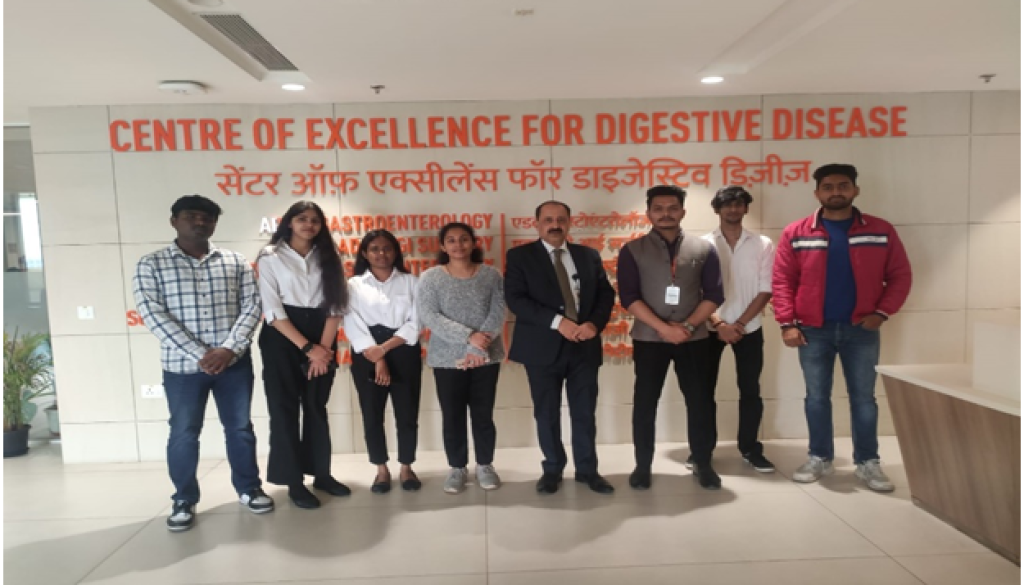Amrita Hospital Visit
School of Management & Commerce organized Amrita Hospital Visit for BBA Health Care Management
Date: 22-02-2024
Introduction: –A visit to a hospital provides practical exposure to the hospital environment, which is a crucial component of the Academic Curriculum of BBA Healthcare Management programs. These visits provide students with a comprehensive understanding of healthcare administration and improve their practical knowledge by immersing them in the intricacies of hospital operations, patient care, and administrative duties.
The Amrita Hospital Team along with their staff extended a hearty welcome to Prof M.K Koul and Students and escorted them to many key Medical departments. The Students got the opportunity to interact with Marketing & Human Resource Head and understood the challenges and the workings of the service sector.
This report offers a summary of numerous departments, including Wards, Radiology, Pathology, Histology, Comprehensive Health Check-up, Dialysis, and CSSD (Central Sterile Services Department), as well as insights into the learning experiences of the students regarding the hospital’s layout and design. These divisions are essential to the hospital’s operation since they provide the best possible care and attention for patients.
Overview of Amrita Hospital
Amrita Hospital is a multidisciplinary tertiary care hospital located in Mata Amritanandamayi Marg,RPS City Sector -88 Faridabad Haryana 121002, known for its state-of-the-art infrastructure, advanced medical technology, and comprehensive range of healthcare services. With a focus on patient-centred care and innovation, Amrita Hospital has emerged as a beacon of healthcare excellence, catering to the medical needs of patients locally and globally.
Architect Briefing in designing of Hospital:The students were briefed about, planning and designing of a hospital, a critical stage that directly impacts its functionality and efficiency in delivering healthcare services. Factors involved layout, infrastructure, equipment, and technology integration are carefully considered to create a conducive environment for patient care. Collaborating with architects, engineers, and healthcare professionals, hospitals aim to optimize space utilization, streamline patient flow, and enhance accessibility to various departments.
Departments visit:
1) Wards:Students were given opportunity to visit critical wards and briefed about significance. They were exposed to different categories based on medical specialty and patient conditions, such as medical, surgical, paediatric, or intensive care units (ICUs) equipped with beds, medical equipment, and nursing stations to monitor patients’ health and provide necessary interventions.
2) Radiology: The students visited Radiology department where they learned different imaging techniques such as X-rays, CT scans, MRIs, and ultrasound to diagnose and monitor medical conditions. They learned how Radiologists interpret images to assist in treatment planning and disease management.
3) Pathology: Students showed interest in investigating and diagnosing diseases in the Pathology Department with examination of bodily fluids, tissues, and organs to diagnose diseases and monitor their progression. Role of Pathologists, to analyse samples obtained through biopsies, blood tests, and other diagnostic procedures to provide accurate diagnoses.
4) Histology: Visit to the Histology department and students came to know how histology is an important branch in disease investigation. They learned that Histology is a specialized branch of pathology that focuses on the microscopic examination of tissue samples. Histologists prepare tissue specimens for analysis, using staining techniques to identify cellular structures and abnormalities indicative of disease.
Comprehensive Health Check-up:Students were demonstrated with Comprehensive health check-ups thorough assessment of an individual’s health status, including screenings for various medical conditions, risk factors, and lifestyle factors. These check-ups often include physical examinations, laboratory tests, and diagnostic imaging to evaluate overall health and detect potential health issues early.
Dialysis: Students visited the Dialysis ward and learned the functioning of Dialysis unit. The Dialysis department provides life-sustaining treatment for patients with kidney failure. Dialysis machines filter toxins and excess fluids from the blood, mimicking the function of the kidneys in patients undergoing renal replacement therapy.
CSSD Department: The students were experienced with CSSD and Process ofSterilization. They learned that The Central Sterile Services Department (CSSD) is responsible for sterilizing and maintaining medical instruments and equipment to prevent infections and ensure patient safety. CSSD staff follows strict protocols for cleaning, disinfection, and sterilization of surgical instruments, Carts, and supplies.
Conclusion: The visit enhanced the knowledge of Hospital operation management in real time. Students showed interest in each and every department and were optimistic to implement in their professional life.




